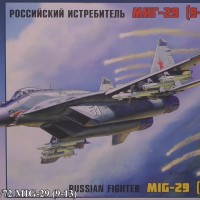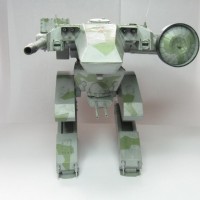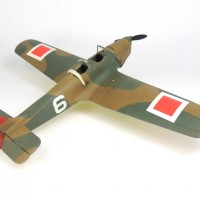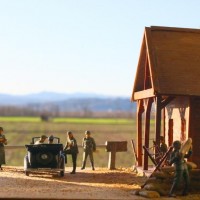Flt Lt Roy French, RAF 1926-2013
The annals of aviation history do not prominently display the name of Flight Lieutenant Roy French, RAF. However, Captain Joseph McConnell, the American ace of aces of the Korean War, had good reason to remember the name. Roy was seconded to the 51st Fighter Interceptor Wing in the fall of 1952 from Fighter Command where he flew Meteors, to gain experience with the USAF and learn the Sabre. He became Joe McConnell's wingman of choice from shortly after his arrival until McConnell went home in May 1953. On the day McConnell was shot down (and shot down the Soviet ace that had shot him down before ejecting) he was wearing Roy's brain bucket, with RAF roundels over the ear pieces. Roy came back to England that summer and later flew Sabres when the RAF got their Mk. 4s. Like pretty much everyone else who flew a Sabre, it was his favorite airplane.
Over the past seven years I knew Roy (he found my model of McConnell's Sabre at Modeling Madness and originally wrote to tell me it was "the most realistic-looking" Sabre Model he'd seen, high praise indeed) I repeatedly tried to get him to let me tell his story after I had pried it out of him, but he always said "But I didn't do anything." Whatever it was he wasn't doing, McConnell certainly appreciated it, and along the way Roy scored two MiG-15s himself, to be among the top scoring RAF exchange pilots during the war.
Today, I got this e-mail from his son Julian:
"We are writing from Dad’s with the sad news that he died peacefully in York Hospital on December 20th. He had been in reasonable health until his last couple of weeks but deteriorated rapidly over the final 36 hours. "
Not a bad way to go - peacefully and quickly. That would certainly be my choice.
I've attached a picture my friend George Paterson did from that model. Since Roy also flew "Beautious Butch/Betty" on occasion, including for one of his victories, we can think that's him under the brain bucket.
I'm sure he and Joe are standing there at the pilot's bar, swapping flying stories and quaffing a few.





Great story! Makes building a model so much worthwhile at times.
Some years back I built a Revell 1/32 Beaufighter and painted it up to represent the Aircraft flown by LtCol Don Tilley (Don and Dierdre Tilley were close friends of my parents, back in the day!) Don flew Beaufighters with19 Sqn South African Air Force when 19 Sqn flew armed interdiction sorties over the Adriatic and Yugoslavia toward the end of the war. He was shot down on one sortie, getting back to friendly lines by help of Yugoslav partisans. Don won the DSO and DFC, and commanded 19 Sqn taking over from Gil Caton, all at the tender age of 24! Previously he had equalled the record number of torpedo attacks flown from Malta in Beauforts, sharing the record with an RAF pilot.
I tried my best to mod the Beaufighter from the MkI to the version 19 Sqn flew. I had unfortunately not heard of the aftermarket kit for this! I cranked up the tailplane to the 10 Deg dihedral, extended the upper engine carb intakes and added some detail to pilot and gunners/observers cockpit. Also cut off the back section of the observers bubble for the dual observer/gunner role the SAAF used. But it should have had the porcupine exhausts and also the little perspex bubble with the DF loop, just behind the cockpit. Not to mention the 60 Lbs rocket rails. The markings I converted to SAAF roundels and painted the little Alpha flight Zulu warrior on the nose. So it looked impressive, as a large scale Baufighter does, but I confess far from perfect.
After carting the model around displaying it in my office for a while, I eventually donated it to the SAAF Museum coffee shop. It stood on a wooden stand and on the base I had pasted photocopied stories and photos about Don, from the photo history book the "SAAF at War" (Stefan Bouwer and Martin Louw). One day Hennie the coffee shop owner came and told me an interesting thing had happened. A lady with her young son had walked into the coffee shop and they had become quite excited about the Beaufighter. Hennie heard her say to the boy, "That's your Grandfathers plane!" Don had a son Frankie Tilley who I had met a few times but over the years had lost touch with, He married a girl called Cathy, and years later this turned out to be her with her son, who decided to visit the SAAF museum that day. Like Tom's story, sometimes model building can be enexpectedly, very rewarding.
So what's the aftermarket set that lets you convert the Revell Beau? That's the one thing that prevents me doing one. I have the hedgehog exhausts from Aires.
Good story, too.
Hello Tom, sorry but I can't recall the name, but was told of either an aftermarket of could in fact have been issued as a complete kit, using the Revell components? I think not available any more sadly. But it allowed you to build a MkX and supplied the weaponry, rockets etc, aswell as the exhausts and correct engine intakes etc. I think Revell could have winner here, if the re-issued an update, of the later Beaufighters as I think the shape/accuracy of the model was pretty good. I think cranking the tailplane up is also only half the problem, as I think along with this, the span was also increased on later Beau's. Maybe without having to mod the moulds too much, Revell could even issue a Beaufort, as it used similar wing and tail components?
Thanks for sharing the story Tom. The in-flight photo of the sabre looks great as well.
It's a PAINTING!
Hope so! Otherwise the model had a long drop to the ground!
truly a cool story and a very fine piece of aviation art
Here's a nice bit of news: I received an e-mail this morning from Roy's son. Roy had never talked about his Korean experience other than he was there. The son has his logbooks, and was wondering who "Joe" was in all the comments from the Korean period. Now he knows. He's going to make a copy of the logbook for me. Also turns out there were a lot of pictures from Korea that now make sense knowing what he did. We may yet be able to tell his story fully for the history books, and get an interesting witness to the life of Joe McConnell.
Great news. So sad to think of how much Second World War experience/combat stories are being/have been, lost, due to the age of veterans of that conflict.
My next book is going to be "USS Corsica: The Real 'Catch-22'". Let me tell you how it started: I was reading the Huffington Post back in November, and there was an article about children of WW2 veterans trying to get their fathers to talk. Among the vignettes in the story was about this woman who had finally convinced her father to go to one of the last reunions of his bomb group - one of the B-25 groups that flew off of Corsica, that were "immortalized" by Joseph Heller in his novel "Catch 22". The article had her full name and where she was from, and a bit of one of the stories her father had told her, which was really good. I read it and thought to myself he'd be a great article in Flight Journal. So I googled her, and she was the only person by that name in that town and there was her e-mail address. So I wrote her a nice polite e-mail telling her who I was and I'd like to interview her father, and attaching a pdf of one of my articles so she'd know I was real and OK. She put me in touch with her dad. We spent time talking about being aircrew (it helped that I was, in a different war) and he told me some stuff, and then he told me some more, and now, as she says "he can't stop talking." All of which makes me feel really good that I facilitated that. And then he put me in touch with some other crews, and all of a sudden I realized that there's this whole air campaign, that nobody knows about other than the novel. They accomplished a helluva lot. Do you know about the Brenner Pass Campaign? I bet you don't, I sure didn't and I am pretty knowledgeable. Between October 1944 and January 1945, they knocked down every bridge and every choke point in the Brenner Pass and completely cut off the Germans from re-supply. A real victory of airpower. Once that happened, the Gustav Line collapsed and all of a sudden the ground forces were in the Po Valley in a matter of weeks. They weren't up against fighters, they were up against flak. And the running joke in the novel about missions being increased just as you got to the magic number was true. After February '45, when they stopped getting replacements, they cut the number of squadrons in a group from four to three, and stopped counting missions. You were there to the end. They got chased to Corsica in spring 1944 by the eruption of Vesuvius in March, which in five days did more damage to the USAAF in the Mediterranean than the Germans did in two and a half years (Foggia, the main base, was right downwind of the volcano). So they got sent to Corsica because there weren't any volcanos. And in doing research to talk to these guys I found two websites run by children of these men, and they have collected stories and letters and diaries and they know the surviving veterans, and when I contacted them they said "Please, can we help you?"
And telling the publisher "the real story of Catch 22" sold it right there. The greatest American war novel of the 20th Century. I read it as a young sailor unknowingly on my way to a war in 1963, and it seemed really crazy, and then the year I cam back the literature professor of my class assigned it and it made perfect sense to me. And all the other kids in the class didn't understand it, but it turned out the prof had done 35 missions in B-24s out of England, so he and I got along great.
A couple weeks ago I saw Rick Atkinson on a TV show and he said that what made writing historical non-fiction so satisfying was that we get to bring the dead back to life. He's right. It's the best damn job in the world.
But what's sad is nowadays I am sprinting to catch the Last Man Standing of the Last Man's Club. But I can say that these guys, all in their late 80s/90s, if I have to live that long I want to do it the way they are.
That seems to me one of the better renditions of the Sabre I've seen painted...as did that Hellcat cover art. Does Mr. Patterson have a web site/ gallery in which we could view his other work? He doe an amazing job IMO.
Yeah well done Tom, too many stories being lost. We had a meeting one night at the SAAF Museum and an old Spitfire veteran told us a story, as an envited guest. To my eternal shame, I've forgotten his name but what a story. They had done a late afternoon ground attack strike on the west coast of Italy north of Ansio and the plan was to recover to Malta to re-fuel. It was tight on fuel, so not much room for errror. As they flew out on the recovery it rapidly got dark and they opened up to individual aircraft. It soon got dark...like in very very dark! At that moment, his Spit suffered total electrical failure. With a black cockpit, making seeing the compass difficult and no way of calling up Malta, he carried on, not being able to see a thing. He realised he would have to jump, hoping he was close enought to get picked up. He said the worst thing was having time to think about it. He took his boots off, and readied himself for a dark parachuting into the sea. Outside it still looked like the canopy was painted black. The cockpit of a single seater, on a dark night with no one to speak to, becomes a very lonely place. Just when he started to think this was it as the fuel gauge needle dropped low, Malta suddenly lit up like a Christmas tree! An air raid was on just at the right time and the island lit up with anti aircraft gun tracer! He immediately turned towards it and was able to land by overflying despite the tracer and opening and closing his throttle whilst orbiting. They put the lights on as they were expecting them, and he landed with a very low fuel state. Those are the details as I remember them. Why I didn't record that at the time, is a tragedy!
Yeah, James, I can kick myself nowadays for the stories I heard 35-40 years ago and didn't record. Didn't know that was going to end up being my career. Those stories like you just described - I mean, 30 years later you remember it in detail! - that's the stuff we should have been saving. Thanks for it,.